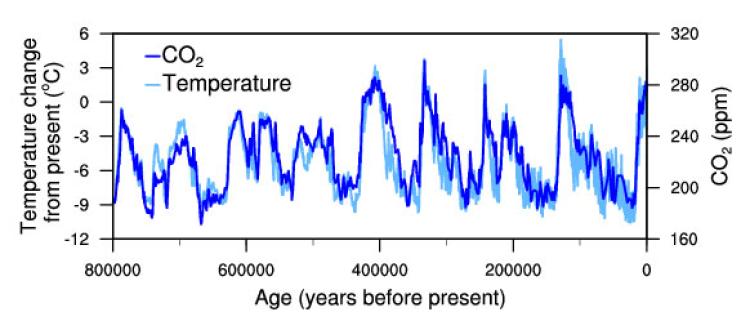CO2 and Milankovitch Mysteries (Spring 2024)
GEOL 5705 - Seminar in Paleoclimate
Benthic d18O Stack
Cenozoic Paleo-CO2

EPICA Dome C deuterium and CO2

Lisiecki and Raymo (2005) benthic d18O stack
Marchitto's seminar courses (archived)
Most are Geological Sciences courses with titles like "Seminars in Paleoclimate". Asterisks* denote courses titled "Super-Problems in Quaternary Climate"
- CO2 and Milankovitch Mysteries (Spring 2024)
- Greenhouse Forcings and Feedbacks (Spring 2023)
- Past Climate Extremes (Spring 2022)
- Presenter's Choice (Spring 2021)
- Rapid Warming, Ocean Acidification, and Anoxia: Lessons from the Past (Spring 2019)
- Paleoclimate Landmarks and Heroes (Spring 2017)
- Paleoclimate Contributions to the 5th IPCC Report (Fall 2015)
- Glacial-Interglacial CO2* (Spring 2014)
- Glacial Ocean Circulation* (Spring 2010)
- Glacial-Interglacial CO2* (Fall 2008)
- Warm Periods of the Earth's Past (Spring 2007)
- Rapid Climate Change: Holocene to Anthropocene (Spring 2005)
- Recent Developments in Rapid Climate Change Research (Spring 2003)
Course description: This course will entail a weekly seminar-style critical reading of journal articles in paleoclimate (one paper per week, curated by the instructor). This year, we will focus on the causes of the ice ages: changes in Earth's orbit around the Sun, variations in atmospheric Greenhouse gases, and interactions between the two.
Expectations and grading: During the semester, each student will be required to lead the discussion of two papers. Each presenter will be selected one week ahead of time. Papers may be presented informally and with or without visual aids, according to the presenter's preference. The presenter should touch on the paper's main Problem, Claim, Evidence, and Uncertainties. Presenters should encourage discussion by asking questions of the group. Each week, everyone is responsible for reading the paper and participating in the discussions. Readers should also identify and share one part of the paper that they had trouble understanding. Grades will be based on overall participation (50%) and on the effort put into the presentations and discussion-leading (50%).
Meets: Wednesdays 12:20-1:10 pm, BESC 340D
Instructor:Tom Marchitto, tom.marchitto@colorado.edu
Office Hours: By appointment
Credits: 1
_________________________________________________________________________________
Course schedule (updated weekly)
We will only be discussing the papers with names assigned after them; any others are for background. Note that most of the links below must be accessed from a campus computer or via a CU VPN. Refresh your browser if links are missing or broken
January 17: Organizational meeting and mini-lecture
January 24: Milankovitch confirmed?
Hays, Imbrie, and Shackleton (1976) Variations in the Earth's Orbit: Pacemaker of the Ice Ages (Rob)
January 31: Polar dominance
Knox and McElroy (1984) Changes in atmospheric CO2: Influence of the marine biota at high latitude (Laurel)
February 7: Carbonate compensation
Boyle (1988) The role of vertical chemical fractionation in controlling late Quaternary atmospheric carbon dioxide (Indigo)
February 14: Polar iron fertilization
Martin (1990) Glacial-interglacial CO2 change: The iron hypothesis (Briana)
February 21: Southern Ocean surface isolation
Sigman et al. (2021) The Southern Ocean during the ice ages: A review of the Antarctic surface isolation hypothesis, with comparison to the North Pacific (Trish)
February 28: Separating the upper and lower cells
Ferrari et al. (2014) Antarctic sea ice control on ocean circulation in present and glacial climates (Kiana)
March 6: Milankovitch progression through the climate system
Imbrie et al. (1992) On the Structure and Origin of Major Glaciation Cycles 1. Linear Responses to Milankovitch Forcing (Tom)
March 13: Does ice volume drive CO2, or vice versa?
Ruddiman (2006) Ice-driven CO2 feedback on ice volume (Laurel)
March 20: It's the rate of ice volume change that matters
Roe (2006) In defense of Milankovitch (Indigo)
April 3: Forget precession and eccentricity, it's obliquity
Huybers (2007) Glacial variability over the last two million years: an extended depth-derived agemodel, continuous obliquity pacing, and the Pleistocene progression (Rob)
April 10: An orbital timescale for CO2
Kawamura et al. (2007) Northern Hemisphere forcing of climatic cycles in Antarctica over the past 360,000 years (Briana)
April 17: Isolating the ice volume component of benthic d18O
Clark et al. (2024) Global and regional temperature change over the past 4.5 million years (Kiana)
April 24: The long view of CO2
CENCO2PIP (2023) Toward a Cenozoic history of atmospheric CO2 (Trish)
May 1: Wrap-up discussion
Some other potential papers (TBD):
- Shackleton (2000) The 100,000-Year Ice-Age Cycle Identified and Found to Lag Temperature, Carbon Dioxide, and Orbital Eccentricity
- Henderson and Slowey (2000) Evidence from U–Th dating against Northern Hemisphere forcing of the penultimate deglaciation
- Raymo et al. (2006) Plio-Pleistocene Ice Volume, Antarctic Climate, and the Global d18O Record
- Elderfield et al. (2012) Evolution of Ocean Temperature and Ice Volume Through the Mid-Pleistocene Climate Transition
- Bereiter et al. (2018) Mean global ocean temperatures during the last glacial transition
- Gray et al. (2023) Poleward Shift in the Southern Hemisphere Westerly Winds Synchronous With the Deglacial Rise in CO2
- Sikes et al. (2023) Southern Ocean glacial conditions and their influence on deglacial events
- Ai et al. (2024) The southward migration of the Antarctic Circumpolar Current enhanced oceanic degassing of carbon dioxide during the last two deglaciations

